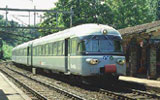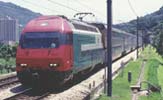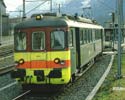|
|
New Orleans and the railroad
(This
letter was sent to the Department of Homeland Security, March 10,
2006)
To:
ready@dhs.gov
Sent: Friday, March 10, 2006 10:37 PM
Subject: New Orleans & Second Dimension Surface Transport Logistics
Platform
Missing
is the railway component in local infrastructure that once was part
of the transport inventory in most USA cities & towns .
I wish to recommend to DHS an article I have published in The Website
of: The Association For The Study Of Peak Oil & Gas, (peakoil.net)
article 374. Along with this reference, a question? Why haven't
obsoleted & retired hopper cars, 1000's annually retired from
the RR's of the USA, been utilized for debris removal in the Gulf
Disaster? This points up the disconnect plaguing a new generation
of leadership that has no knowledge or imagination regarding the
railway mode in disaster remediation.
Up intil the 1960's or so, Railway was understood to be the "Second
Dimension Surface Transport Logistics Platform"- a stand alone
system/network that has in-house capability to maintain operations.
Has DHS noted independent & apolitical (CSX) railway ability
to get bridges and trackwork back in operation to the Port facilities
in New Orleans? Why weren't other secondary lines rehabbed under
direction of DHS for the purpose of increasing ability and speed
regarding removal of debris? Why not even now? Much remains to be
done...
I wish to meet or at least teleconference with DHS staff regarding
re-establishing the rail mode as an integral part of the Homeland
Defense methodologies for rehab, distribution, and logistics. Further,
I am interested in beginning a program of cataloguing ALL retired,
abandoned, and otherwise unused rail corridor, including ALL branchline,
Electric Interurban Systems, and warehousing trackage footprint,
privately operated; as well as extant and formerly existing on Military
bases in the continental US. Victuals centers, rail served, must
be part of the homeland defense policy mainstays.
I have already made contact with Mr. James Woolsey, at Booz, Allen
& Hamilton, regarding researching and compilation of a compendium
of maps, including all mid-century Thomas Bros. City & County
maps showing downtown victuals warehouse track geometry & footprint.
These should be available as a set, in every regional FEMA office,
with appropriate locales' sets for every *logistics official in
all the State National Guard headquarters.
This is admittedly over the head of the first screener- kindly cc
the Director, and persons intermediate in the chain of command that
have to do with disaster scenario regional resupply. Please include
cc each regional manager in the individual regions. EVERY responsible
party dealing with rebuild, evacuation, resupply, or relocation
of populations needs to have available current mapping of rail corridor,
including operations status of track if still insitu, corridor,
etc.
Also, incremental rehab of critical spurs, victuals warehousing
links, equipment sources and suppliers should be readily available
for time of need. Determination of suitable branchline operators,
contractors, and mainline rr personnel, including retirees qualified
in operations and maintenance should be identified, including use
of advertisements asking for volunteers to be on lists of rr qualified
staff and managers.
*Finally at this point of contact, it is suggested that the US Transportation
Command, who purportedly still maintain RR operating capability
at Fort Eustis, should be engaged as an office to liaison with all
the individual State National Guard units, via the Governor's office
of the respective States, for the purpose of establishing a cadre
of railway savvy personnel sufficient in number to independently
act as federal presence in a general disaster scenario, widespread
quarantine requiring rail victuals deliveries, etc. In line with
these proceedings, the US Army Transportation Command should either
cross train trucking personnel with the necessary knowledge and
hands-on railway experience, and/or add appropriately to staffing
to deal with homeland railway operation responsibilities if and
as required. For example, widespread contagion by debillitating
flu, may disable trucking in various victuals delivery/distribution
schedules, requiring rail/military trucking interface. This points
up and explains need for re-established victuals logistics at military
bases across the country.
This call to revisit the railway component in US strategic logistics
is prompted in part by the complete lack of awareness of rail component
utilization for disaster remediation in the September flooding and
subsequent breakdown in the Gulf States. Which continues, sadly,
thru the present time.
I am hoping to hear acknowledgement of these particulars in the
next week or ten days. I will cc other parties, as time passes,
regarding the strategic need for re-emphasis of the railway component,
and the requisite role of the railways in meeting the inexorable
consequences of oilwell depletion on transport, agriculture, and
natural or man made events that occur from time to time, that require
the "Second Dimension Surface Transport Logistics Platform".
Please do follow thru, including CC to Mr. Chertoff's logistics
management staff.
Thank you very much; this is not an easy thing to handle, but it
is necessary to put back in place this critical component of homeland
security/defense capability. Costs of implementaion can be minimized
with incremental steps, most importantly the mapping/cataloguing
and prioritization of rail corridor rehab.
Gunnar Henrioulle, Associate, Tahoe Valley Lines.
|




